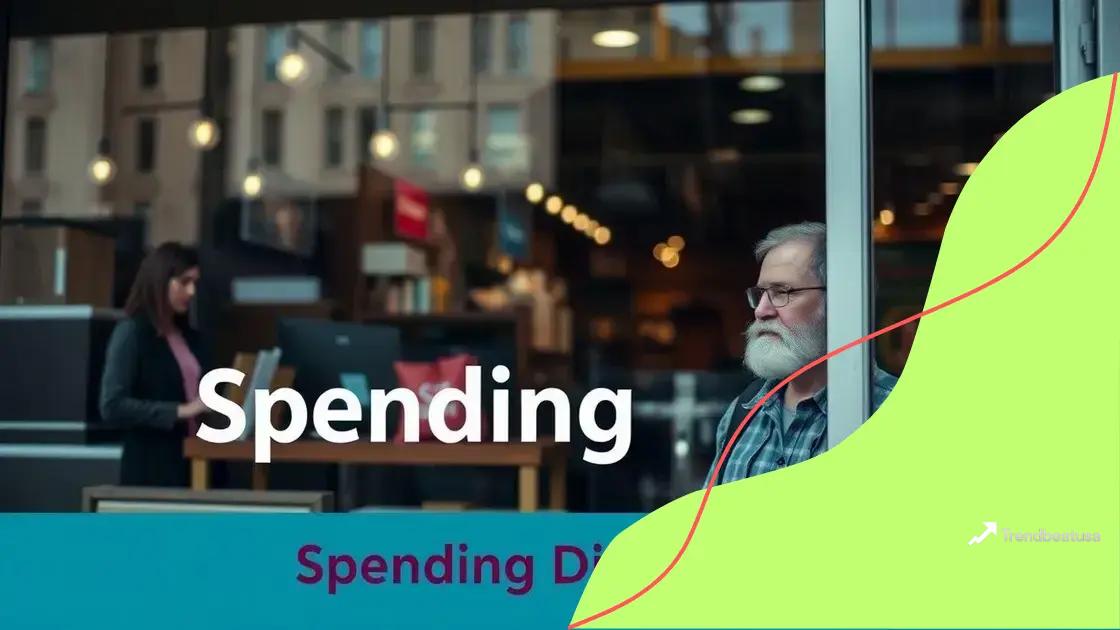Consumer spending dips in Q2: what it means for you

Consumer spending dips occur due to factors like inflation and economic uncertainty, leading to reduced sales for businesses and prompting consumers to prioritize essential purchases while adopting budgeting strategies.
Consumer spending dips in Q2 might have caught your attention lately. It raises questions about what this means for your finances and the economy as a whole. Let’s dive into the implications and explore how we can adapt to this shift.
Understanding consumer spending trends
Understanding consumer spending trends is crucial for grasping the overall health of the economy. By analyzing these trends, we can uncover valuable insights into how and why people decide to spend their money in particular ways.
One important aspect to consider is the various factors that influence spending. These can include:
Economic Factors
People often adjust their spending according to economic conditions. When the economy is doing well, folks feel more confident and spend more money. However, during downturns, they may become more cautious.
Psychological Factors
Consumer confidence plays a big role in spending decisions. If people feel secure in their jobs and finances, they are more likely to spend. Conversely, fear and uncertainty can lead to reduced spending.
Seasonal Trends
Certain times of the year see increased spending, such as holidays or back-to-school seasons. Understanding these patterns helps businesses prepare for fluctuations in sales.
Technological Influence
Technology has changed how we shop. With online shopping on the rise, consumers often find it easier and faster to make purchases. This shift has a significant impact on overall spending.
- Economic conditions influence confidence.
- Psychology affects consumer choices.
- Seasonality leads to spending spikes.
- Technology changes shopping habits.
In summary, understanding consumer spending trends involves looking at multiple factors, from economic conditions to technological advances. By keeping an eye on these elements, individuals and businesses can make informed decisions and better navigate the ever-changing market landscape.
Factors contributing to Q2 spending decline
Several factors are contributing to the Q2 spending decline. Understanding these elements can help businesses and consumers alike navigate the changing economic landscape.
First, rising inflation has made goods and services more expensive. When prices go up, consumers often cut back on non-essential purchases. This shift in spending behavior directly impacts various industries. Additionally, economic uncertainty plays a significant role in how individuals approach their finances.
Key Factors Influencing Spending
A variety of factors influence consumer spending habits. One major factor is:
- Inflation: As prices rise, consumers become more cautious with their money.
- Unemployment Rates: High unemployment can lead to decreased consumer confidence.
- Interest Rates: Increased interest rates can discourage borrowing and spending.
- Consumer Confidence: If people feel uncertain about the economy, they are likely to spend less.
Moreover, seasonal trends can also impact spending. For instance, after a busy holiday season, many consumers may tighten their budgets to recover from their expenses. This trend can lead to a natural decline in spending in the following months. Understanding Q2 spending declines is essential for businesses to adjust their strategies.
Finally, consumer behavior is shifting towards saving rather than spending. As people become more aware of their financial situations, they are becoming more inclined to save for the future. This conscious effort has a ripple effect on various industries, as reduced spending can lead to lower sales and revenue for businesses.
Impact of spending dips on businesses

The impact of spending dips on businesses can be significant and wide-ranging. As consumer spending decreases, businesses must adapt to the changing economic environment to survive and thrive.
One major effect is reduced revenue. When customers cut back on their spending, sales often decline, which can lead to financial strain for companies. Smaller businesses tend to feel these effects more acutely since they often operate on thinner margins. Larger corporations might be able to absorb some of the losses, but even they can face challenges.
Strategic Adjustments
Businesses may need to rethink their strategies in response to spending dips. This includes:
- Cost Reduction: Companies may look for ways to cut expenses, such as reducing staff hours or renegotiating supplier contracts.
- Marketing Efforts: Focusing marketing on value propositions can attract more customers looking for deals.
- Product Adjustments: Businesses might modify their offerings to better match consumer demands during downturns.
- Diverse Revenue Streams: Exploring new markets or product lines can help cushion the business from spending fluctuations.
Additionally, spending dips can lead to changes in consumer behavior that businesses must address. Customers may prioritize essential items over luxury goods, prompting companies to adjust their inventories. This shift can influence which products are emphasized in marketing campaigns.
Finally, businesses may utilize technology to enhance customer engagement. More businesses are turning to online platforms and social media to connect with their audience. This shift not only helps in maintaining visibility but also allows for better understanding of changing consumer preferences.
Strategies for consumers during dips
During spending dips, consumers can adopt several strategies to manage their finances effectively. Being proactive during these times is essential to maintaining financial health while making wise purchasing decisions.
One important strategy is budgeting. By creating a detailed budget, consumers can track their spending and distinguish between wants and needs. This clarity helps in prioritizing essential expenses and avoiding unnecessary purchases.
Practical Tips for Consumers
In addition to budgeting, there are specific actions consumers can take:
- Focus on essentials: Prioritize spending on necessary items such as groceries, housing, and healthcare.
- Seek discounts: Look for sales, coupons, and loyalty programs to save money on purchases.
- Consider alternatives: Explore less expensive brands or generic products as potential substitutes for name brands.
- Delay non-essential purchases: Postpone buying luxury items or services until there is more financial stability.
Additionally, consumers can leverage technology to their advantage. Many apps and online tools help in tracking spending and finding great deals. Using these resources can lead to smarter shopping choices and increased savings.
Lastly, maintaining an open line of communication with family members about finances can empower households to make collective adjustments. Discussing financial goals and challenges creates a supportive environment and encourages responsible spending habits.
Future predictions on consumer spending
Future predictions on consumer spending suggest that trends will evolve in response to various social and economic factors. Understanding these potential shifts can help both consumers and businesses make informed decisions.
Economic experts forecast that technological advancements will continue to influence consumer behavior. With more people shopping online and using mobile payment options, convenience will drive spending patterns. As technology becomes more integrated into daily life, consumers are likely to prioritize seamless experiences.
Key Trends to Watch
Several key trends may impact future consumer spending:
- Increased Focus on Sustainability: Consumers are becoming more environmentally conscious, often favoring brands that prioritize sustainable practices.
- Shift Towards Experiences: Many consumers are valuing experiences, such as travel and dining, over material goods. This trend may lead to increased spending in the service sector.
- Health and Wellness Spending: The pandemic has heightened awareness around health. Future spending may reflect a stronger demand for health-related products and services.
- Adaptation to Economic Changes: Economic fluctuations, such as inflation or recession, will continue to shape spending behaviors. Consumers may adjust by focusing on value and affordability.
Additionally, demographic shifts will play a crucial role. As younger generations, like Gen Z, become more prominent in the marketplace, their preferences will influence brands and retailers. This cohort cares deeply about social issues and expects transparency from companies.
Moreover, understanding the impact of global events, such as economic policies or environmental changes, can provide insight into how consumer spending may shift in the future. Being aware of these dynamics enables businesses to adapt their strategies proactively.
In conclusion, understanding the impacts of consumer spending dips allows both consumers and businesses to make informed decisions. By recognizing the factors at play, adopting effective strategies, and staying aware of future trends, everyone can navigate these economic challenges more effectively. Staying proactive and flexible is key to thriving in an ever-changing marketplace.
FAQ – Frequently Asked Questions about Consumer Spending Trends
What factors contribute to consumer spending dips?
Factors include rising inflation, economic uncertainty, and shifts in consumer priorities.
How can consumers manage their finances during spending dips?
Consumers can budget effectively, prioritize essential purchases, and seek discounts to manage their spending.
What strategies should businesses adopt in response to spending declines?
Businesses should reduce costs, adjust marketing efforts, and potentially diversify their offerings to adapt to reduced consumer spending.
What future trends are expected in consumer spending?
Future trends include a focus on sustainability, experiences over products, and an increase in online shopping as technology evolves.
